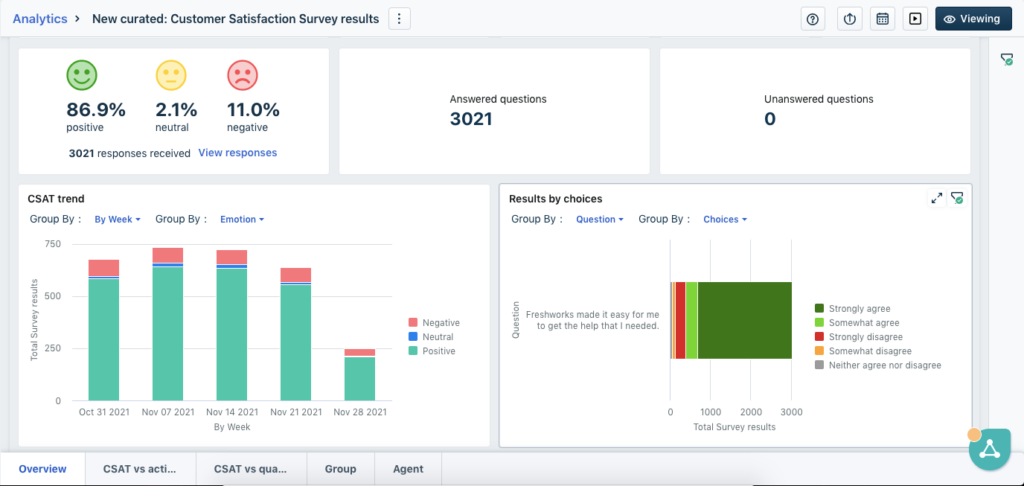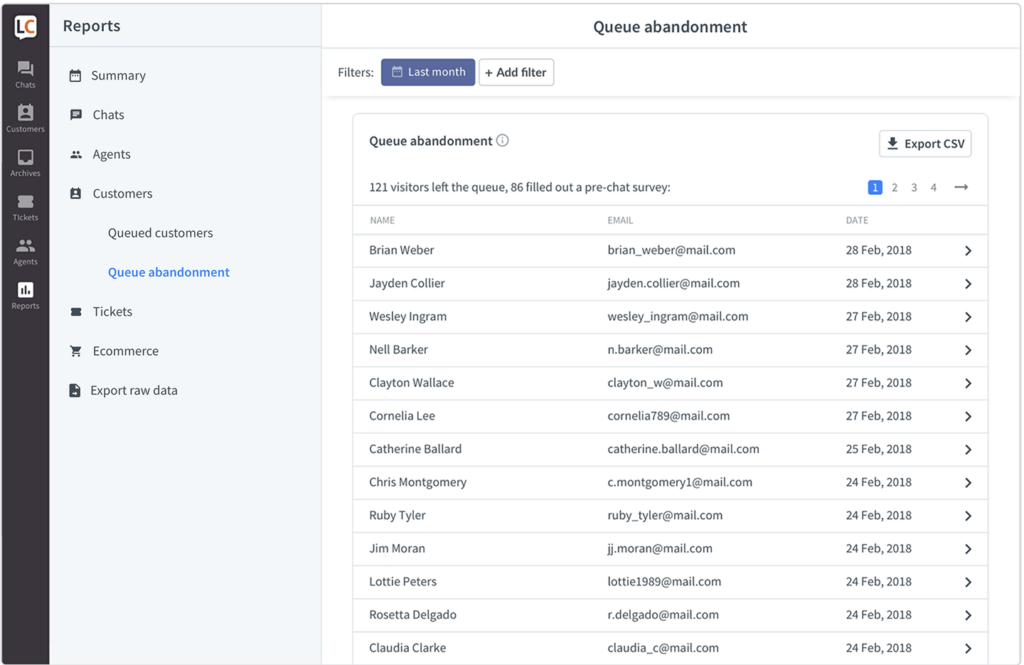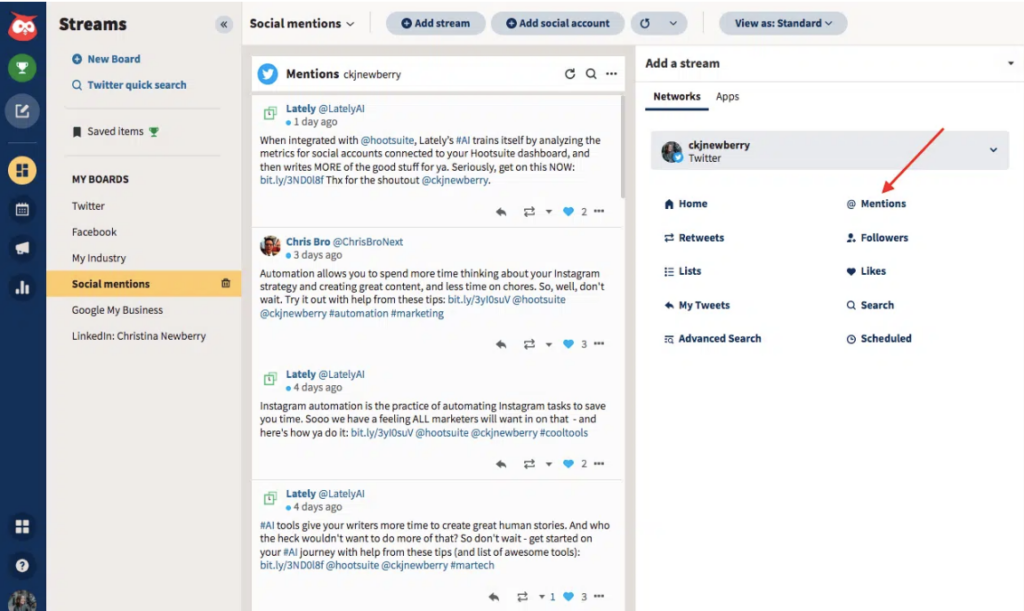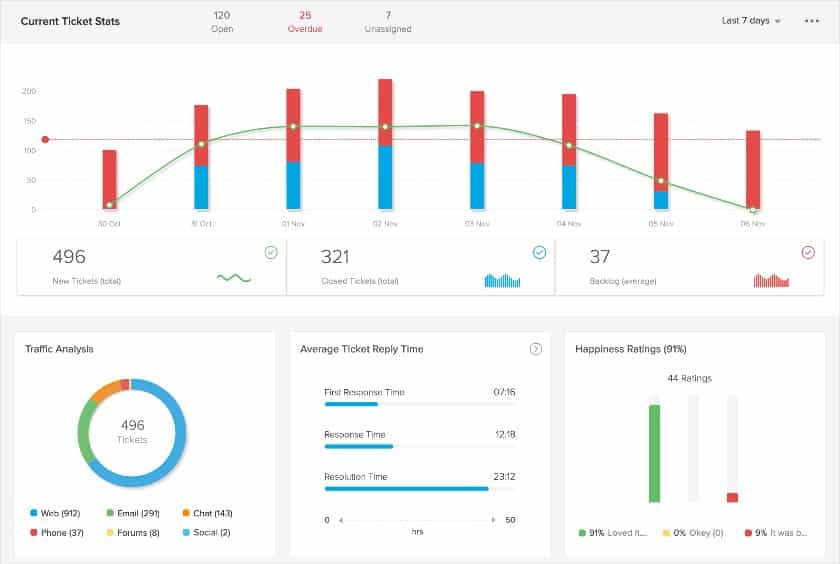You can measure customer satisfaction by reviewing surveys, ticket resolution rates, Net Promoter Scores (NPS), and social media sentiments. But to get an overall picture of your team’s performance, you’ll need to learn how to measure customer service satisfaction using multiple methods. In this article, we’ll discuss how to measure customer satisfaction using the top performance indicators and software tools for measuring these metrics comprehensively.
1. Determine Your Customer Satisfaction Score (CSAT)
One of the best ways to measure customer satisfaction is by determining your customer satisfaction score (CSAT). This step involves gauging your customers’ sentiments after receiving support from your business. Getting your CSAT can be done through forms or surveys usually sent via email and are triggered upon the closure of a ticket or a case.
CSAT monitoring provides a straightforward sentiment evaluation asking customers to rate the quality of support they received from very good to very bad. Customers are also usually asked to leave comments and provide context to their chosen response.
To manually calculate your customer satisfaction score, use the following formula: (total number of positive responses / total number of all responses) x 100.

Freshdesk’s report on customer satisfaction survey results (Source: Freshdesk)
Freshdesk has customer service measurement tools like surveys and forms that users can easily create and share with their customers each time they resolve an issue. In the dashboard, the system shows real-time tracking of sentiments based on responses received. It also shows the number of responses recorded versus the number of recipients who received the survey.
2. Calculate Your Net Promoter Score (NPS)
Your NPS measures customers’ likelihood of recommending your business or brand to their peers. It’s one of the customer service metrics examples that managers can use as a basis for measuring an agent’s performance during call listening or one-on-one coaching sessions. Businesses use this metric to evaluate their overall customer service quality and, in turn, increase customer loyalty.
Learn how to quantify customer service using NPS surveys by asking customers to rate their customer service experience with the company on a scale of 1 to 10, with one being the lowest and 10 being the highest. You can also tweak the question and directly ask how likely they are to recommend you to their family and friends. Users can then categorize the respondents into three segments: detractors, passive customers, and promoters.
To manually calculate your NPS, simply subtract the percentage of detractors from the percentage of promoters and multiply it by 100.

HubSpot’s Service Hub customer feedback report (Source: HubSpot)
HubSpot Service Hub includes an NPS tool that makes it easy for you to keep track of your customers’ satisfaction level and likelihood to recommend—especially if you are using it together with the HubSpot CRM tool. Service Hub lets you easily create and share the survey with your distribution list, and the system will automatically calculate the score for you.
3. Check Your Support & Call Abandonment Rate
Support or call abandonment rate determines the number of customers who give up trying to reach your customer service team before an agent gets to entertain their call or query. There are a number of reasons for this—one of which involves customers discovering the answer to their questions independently using information from your website. In some cases, they’ve simply gotten frustrated waiting for an agent to help them.
No matter what their reason is for leaving the support queue, having a low abandonment rate helps improve your overall customer service quality as your agents can talk to your customers directly and better understand their concerns. A high support abandonment rate can leave an unreliable impression among your customers. It may also mean you don’t have enough agents to handle the volume of queries you receive.
To manually calculate your call abandonment rate, subtract the calls you’ve handled from your received calls. After that, divide the difference by the number of calls you’ve received and multiply it by 100.

LiveChat’s queue abandonment report view (Source: LiveChat)
LiveChat lets users process customer service requests through live agents chats or chatbots. For example, suppose a customer drops out of a queue while waiting to speak with an agent. The agent can then send a follow-up message as the chatbox requires customers to enter their contact information before being placed in the queue. That way, the agent can determine the reason for the customer’s action and proceed with the best next step.
4. Monitor Your Social Media Sentiments
One of the most impactful customer service best practices today is monitoring social media sentiments. Customers usually use social media to share their brand experiences, which should prompt your sales and customer support teams to use social media to measure customer service satisfaction. It helps you stay updated about what your customers are saying about you and measure their sentiments.
Monitoring social media sentiments alerts you of any issues that need attention so you can reach out to customers for a resolution. Therefore, it’s crucial to monitor social media mentions, especially if you have a large customer base, using a social listening tool so you can sweep the online space accurately. These tools usually have advanced analytics capabilities that can measure sentiments through keywords from your customers’ social media posts.

Hootsuite sentiment analysis tracks social media mentions (Source: Hootsuite)
Hootsuite is a social media management platform that allows users to respond to customer mentions of their brands, as well as evaluate and measure their customers’ post sentiments. This will enable businesses to gauge if their customers are posting positively or negatively about their brand, which can affect your customers’ overall brand perception. While it is not customer service software, Hootsuite can be integrated with service customer relationship managers (CRMs) or customer service tools.
5. Evaluate Your Case Resolution Rate & Duration
The goal for every ticket created in your customer service tool is to be resolved properly and promptly. Not being able to resolve a case doesn’t give a good impression to the customer, and not being able to act on it quickly also causes frustration.
One of the areas to look into when measuring the quality of customer service for small businesses is the total number of resolutions and the average time to resolve a case. The goal is to increase the percentage of your resolution rate and decrease the average duration of your resolution time.
To manually calculate the percentage of total resolutions, divide the number of tickets created by the number of resolved tickets. Meanwhile, to get the percentage of the average duration to settle a case, use a time tracking tool (usually included in customer service software) and get the average duration over a specific time.

Zoho Desk provides a robust overview of current ticket stats (Source: Zoho Desk)
Zoho Desk provides customer service performance reports that show different aspects of your support activities, including several currently active tickets and communication channels used to raise an issue. Users can see their overall average ticket reply time in its dashboard, including the first response time and total time to resolve issues.
6. Measure Your Customer Churn & Retention Rate
One of the critical customer service performance metrics is customer retention rate, indicating a customer’s willingness to keep purchasing your offerings. Therefore, it is important to learn why your customers are sticking with you or leaving you for your competitors. While customer churn and retention can be calculated manually, using artificial intelligence (AI) tools for customer service is helpful because it can process large amounts of data, predict trends, and monitor the factors that affect your retention or churn rate in real time.
Customer retention rate reflects the number of customers that you keep, while churn rate reflects the number of customers that you lose. To calculate the customer retention rate, get the number of existing customers at the end of the period and subtract the number of acquired customers during that period. Then divide the difference by the number of customers at the start of that period and multiply the result by 100.
Salesforce Service Cloud predicts customer churn rate through its AI tool, Einstein. Its churn prediction functionality gets insights from customer data to predict customers’ willingness to continue buying products from a business. These factors include case history, resolution information, product purchase history, and customer communication. By taking cues from these data, the system can predict churn rate and highlight issues affecting it.
Frequently Asked Questions
Businesses must measure customer service satisfaction to identify areas for improvement in their standard practices. Customer service management (CRM) and help desk software systems have analytics, reporting, ticketing, survey forms, and other tools for this essential task.
Getting feedback about your customer service performance is one of the most effective ways to evaluate your efforts’ effectiveness. For example, it’s a common practice for agents to do this after resolving a problem or a call. Sending email survey forms after closing a ticket is another way to measure customer service.
Data analytics can be used to gather information for major customer service KPIs, like net promoter score (NPS) and customer satisfaction score (CSAT). Advanced reporting tools with artificial intelligence (AI) capabilities help analyze real-time customer service metrics. CRM systems and help desk software programs usually have these features built-in or integrated.
Bottom Line
Knowing your customers’ sentiment toward the quality of customer service you provide is essential in running a well-oiled business. And while customer satisfaction surveys are straightforward, remember that they are not the only way to measure customer satisfaction—you can also explore other areas such as customers’ likelihood to recommend, customer churn and retention rate, and social media sentiments.